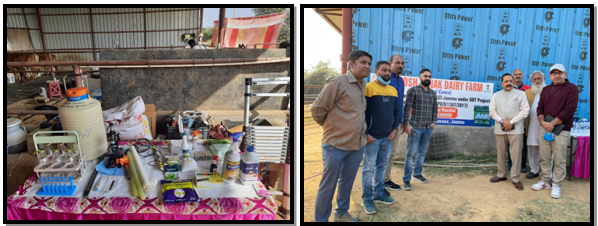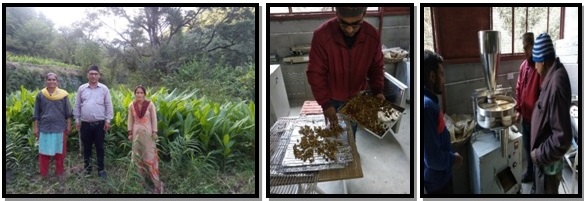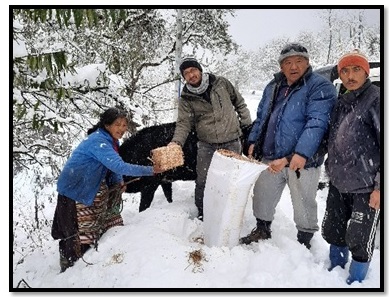Biotechnology, besides contributing to academics, research and economy, has immense potential to directly improve the lives of socially and economically weaker sections of the society. The fruits of biotechnology based research and innovation can be utilized to provide platforms for self-employment generation among the target population by diffusion of proven and field-tested technologies in a plethora of fields ranging from agriculture, secondary products of agriculture, food processing, animal husbandry and many others. Notably, the benefits of biotechnology based interventions are all-encompassing and cuts across sectors that have a direct influence on means of daily livelihood and income.
Biotechnology based programme for societal development was initiated by DBT in 1990 to benefit the vulnerable section of the society particularly farmers, women and SC/ST population with a special focus on youth belonging to these sections of the 130 crores population of India. In course of this journey of three decades, emphasis on different sectors have been realigned several times in consonance with the Sustainable Development Goals (SDGs) adopted by the United Nations and national priorities of India.
The NITI Aayog had identified 117 Aspirational districts in 2018 based on 49 indicators across five sectors that include health and nutrition, education, agriculture and water resources, financial inclusion and skill development, and basic infrastructure. DBT is currently engaged in ensuring enhancement of the Human Development Index in these districts through focused interventions under its Biotechnology based programme for societal development.
Mandate
The specific aim of Biotechnology based programme for societal development is the socio-economic upliftment of the underprivileged section of the society with the following objectives:
- To promote the use of biotechnological processes and tools for the benefit of under privileged section of the society comprising of women, rural, SC/ST population and weaker section.
- To develop programmes on agriculture and allied areas; health, hygiene and nutrition; biodiversity conservation and sustainable utilization of resources for societal benefit.
- To create a platform for livelihood, self-employment generation and entrepreneurial activities among the target population by diffusion of proven and field-tested technologies through demonstration, training and extension activities.
- Science outreach & public engagement.
Expected outcomes and deliverables:
- The project should clearly bring out the benefits to the target population through technology transfer using locally available bio-resources.
- Attention should be paid on income and employment generation in addition to change in their lifestyle in terms of monetary gain or improvement in health and nutrition status, skill development or entrepreneurship creation through biotechnological interventions.
- The project should create avenues for the target population to get relief from drudgery and in turn encouraging them to stay back in their areas, inculcate a spirit of bio-entrepreneurship and stop migrating to the cities.
- The activity undertaken should be employment/revenue generating and not job displacing.
- Activities undertaken should pertain to the judicious utilization of bio-resources leading to sustainable development in the implementation area through the involvement of target population in farm activities. It should not lead to environmental degradation or ecological imbalance.
- During the project duration, implementing agency should encourage formation of cooperative societies / Self Help Groups to continue the activity in a sustainable manner.
- After termination of Govt. support, assets generated are required to be transferred to the cooperative societies / SHGs formed. As far as possible, assets created from the DBT supported funds should be placed in the vicinity of the beneficiaries in the project operational area.
Achievements
- In last 3 years:
| Number of hands-on trainings/workshops/awareness programmes conducted | 504 |
| Number of beneficiaries trained | 9015 |
| Number of Self Employment Generated | 408 |
- During FY 2021-22, 27 new projects recommended in Aspirational Districts.
Success Stories:
Glimpses of some of projects supported under Societal Development Programs are as given below:
Jammu and Kashmir imports milk from neighbouring states as the prevalence of cattle diseases like mastitis, severely mar their milk production capacity. Department of Biotechnology under its societal project has selected SC/ST population of four villages in Jammu district and trained over 370 farmers for profitable dairy farming using scientific interventions. Skill development workshops were organised to enhance their technical skills in farm management. This has motivated and nurtured many new farmers to venture into start-ups in the dairy sector. Now they are earning two to five times more than their previous income. Notably, a high percentage of youth with impressive pay packages in the private sector have started dairy farming. There are around 20 success stories under this project where youth have initiated dairy start-ups and have established successful businesses.

Fig: Training of usage of milk testing kits and modern dairy equipment to beneficiaries; and visit of Hon’ble Minister of State (IC) of Science & Technology to a beneficiary dairy farm.
-
Two nutraceutical products namely, Sahjan leaf powder dietary capsules and Sahjan-fortified wheat flour puri have been developed by CSIR-NBRI under another Societal Development Program of DBT. These products have reduced malnutrition problem in growing children and women of targeted area.
-
A project being implemented by Indian Institute of Technology Roorkee aims at pursuing the interventions such as Value addition, product development, and entrepreneurial skill development-based innovations for rural and societal development in traditional Medicinal and Aromatic Plants based products of the hill areas focused on North-West Himalayan Region. The beneficiaries have been provided with the quality germplasm of the identified MAPs for cultivation. A processing facility housing the interventions for post-harvest management, and processing of MAPs is established for the beneficiaries. The beneficiaries are being trained for organic cultivation, post-harvest processing of MAPs, and product development based on MAPs along with skill development for entrepreneurial practices and support for market development. ICT-based interventions are being implemented for strengthening the connections, providing marketing and selling platform and developing the brand for the products developed through scientifically validated traditional practices. The beneficiaries have started developing the products based on MAPs along with selling in the local markets.

Fig.: Organic cultivation of germplasm and beneficiaries using processing facility.
-
Another project is involved in Millets Processing & value addition Training at Farm Gate and marketing linkages. Women from a small village of KattiTugaon, Bhalki Taluk Bidar district of Karnataka have started a Self Help Group called “TRIDALA SELF HELP GROUP”. The women were provided training on business plan, processing of millets and market linkages to get remunerative prices for products. The products like Pearl Millet Muruku, Ragi Malt, Multimillet Malt, Ragi Masala, Roti Powder, millets Papad and Millets Khichadi Mix etc., are being prepared by these SHG members. Many other farm women were inspired by this SHG group and as a result now more than 30 members are working in this group and selling their produce across the country. Today Tridala women SHG is a role model to other women in the village.
-
High altitude livestock such as yak,plays a major role in the economy of the tribal population, living in the difficult terrains of the foot hills of

Himalayas. Yaks are raised on free range transhumance system of rearing without any supplementary feed, except some salts at regular interval. The entire yak rearing areas of the country face acute shortage of fodder during winter when entire pastures remain covered under snow and due to dormant biomass growth. Beside, over grazing of winter pasture due to over stocking with other livestock resulting in their deterioration. This results in substantial loss in animal body weight and production. These losses could be compensated by supplementation of complete feed blocks prepared from locally available fodder resources such as maize stover, paddy/millet straw and concentrated feed. Silage making in poly bags in another technology of conservation of surplus green forages for lean period. The technology is found effective in ensiling high altitude tree forages like Willow tender twigs and leaves for offering to the animals during feed scarcity periods. Both these technologies have been extensively demonstrated and popularised among the highland farming communities of Arunachal Pradesh and North Sikkim. The technologies have been given to the state developmental agencies; Animal Husbandry department and Krishi Vigyan Kendra of Tawang and West Kameng in Arunachal Pradesh and North Sikkim for further percolation in field. Complete Feed Blocks (CFB), made from locally available feed resources to combat winter feed crisis in yaks, has been distributed and found effective in recouping 25-30% of body weight loss in yaks during winters.

Fig:CFB distribution and technology demonstration to the farmers in Sikkim
-
Farmers from Kelambe village in Lanja Taluka of Ratnagiri district of Maharashtra, having livelihood agriculture farming mainly horticulture crops like coconut, cashew and Amla, were trained in integrated farming practice by incorporating fish culture and utilising waste water from fish culture unit as a source of nutrient for horticulture crops. The farmers were trained for constructing polythene lined ponds in his unused land of for supporting irrigation to horticulture crops and fish culture. The intervention has resulted in increase in income and productivity of horticultural crops as well.

Fig: Fish culture farms; Seed stocking and Health check-up and monitoring on site.
Techनींव@75
As part of AzadiKaAmritMahotsav, SEED Division of Department of Science & Technology (DST), in collaboration with the Department of Biotechnology (DBT), Council of Scientific and Industrial Research (CSIR) and MoES, has taken the initiative “Techनींव@75”, to highlight the impact of STI in creating an enabling environment & improving the absorption capacity of communities.
Starting 15th November 2021, the programme is year-long of 75 hours. The programme has been structured to bring on-board community groups, Changemakers, and other stakeholders for their experience sharing. More details are available at https://www.indiascienceandtechnology.gov.in/techneev@75
Frequently Asked Questions (FAQs)
1. Who can apply?
- Faculty from Govt. recognised universities, National level laboratories, Autonomous Institutions and Colleges
- Partially funded KVKs
- Voluntary organizations/ NGOs/ social trust/ foundations (subject to fulfilment of criteria mentioned in the Guidelines). However, in case of NGOs and Private organizations projects should be submitted in collaboration with other government funded agencies/ institutes with proven track record.
2. When is the call for proposals announced?
The ‘Call for Proposals’ is advertised on an annual basis on the DBT website. Proposals should be submitted online through the online submission portal e-ProMIS.
3. What are the sectorial priorities of DBT under the Biotechnology based programme for societal development?
Projects are being supported (but not limited to) in the areas viz. agriculture and allied sector, health & sanitation, environment & biodiversity conservation, animal husbandry, dairy, fisheries, integrated farming, product / process development and value addition, through training and demonstration activities with a little support on R&D aspects for addressing specific problems in development of technology packages, refinement and validation to suit different agro climatic conditions.
Support is also extended for biotechnological interventions in the areas of bio¬fertilizers, bio-pesticides, sericulture, mushroom cultivation, bee keeping, Spirulina production, organic farming, vermicomposting, floriculture, cultivation of medicinal and other economically important plants, bio-waste utilization and solid waste management, marine and aquatic bio-resources utilization, preparation of products from forest produce, cancer screening, addressing women and child related health issues, screening and genetic counselling for various genetic disorders among the communities etc.
The Department has attached prime focus on establishment of Rural Technology Clusters(RTCs) across 117 Aspirational districts of the country. The RTCs are envisaged to serve for utilization of locally available bioresources benefitting the youth, women, SC/ST population or the rural community at large.
4. What are the essential parameters for screening of new proposals?
- The proposal should be specifically aimed on field demonstration/extension oriented activities for the welfare of society (SC/ST population, Aspirational districts, rural population, women and youth).
- The biotechnological interventions/techniques should be clearly mentioned.
- Since the aim is to utilize protocols/technologies/interventions which have been proven/developed in the laboratory, a very little R&D component may be included for standardization/ refinement. The Department may not consider proposals purely based on R&D without any outreach activity.
- The methodology, organization of work elements and time schedule of activities giving milestones should be clearly mentioned.
- The targets and milestones should be laid on a quarterly basis and they should be quantifiable.
- The list of beneficiaries should be provided both in terms of number of persons and number of families covering with clusters, villages, blocks etc.
- Marketing linkages with documentary evidence and buyback arrangements should be clearly specified in the project with necessary evidences. If organization is opting for buy-back, it may clearly be indicated that how the organization will be disposing the material in the market.
- No support would be provided for construction and related activities. Formation of Self-Help Groups (SHGs)/Cooperative Societies is encouraged. The SHGs/ Cooperative Societies are expected to provide the physical infrastructure required for operation of RTC activities.
5. How is a new proposal processed?
- Applications must be submitted through the online portal of DBT e-ProMIS and all mandatory information should be furnished.
- Applications shall be screened by an expert Committee constituted by DBT and PIs shall be called for presentation before the Task Force. Site visit, if required, will be undertaken to arrive at final decision. Decision of Task Force will be final.
The decision of the Expert Committee is generally communicated to all applicants via email along with the observations of the Committee.
For discussion or evaluation of proposals, members of committee must declare a conflict of interest if they or close professional associates will or might benefit, directly or indirectly, from any support. The potential Conflict of Interest will be discussed and rated as high, medium or low and the member(s) will be either asked to leave the meeting for the duration of Committee’s deliberations regarding the relevant proposal, or to refrain from any discussion and participation in decisions related to the proposal(s).
Contacts Concerned Officer for more Information
| Name of Officer | Phone No. | |
|---|---|---|
| Dr. Vinita Nitin Choudhary, Scientist E | vinita[dot]chaudhary[at]nic[dot]in | 011-24362885 |
















